
Chameleons or chamaeleons are a distinctive and highly specialized clade of Old World lizards with 200 species described as of June 2015. The members of this family are best known for their distinct range of colors, being capable of shifting to different hues and degrees of brightness. The large number of species in the family exhibit considerable variability in their capacity to change color. For some, it is more of a shift of brightness ; for others, a plethora of color-combinations can be seen.

Bradypodion is a genus of chameleons in the family Chamaeleonidae, collectively called South African dwarf chameleons. All species are found in South Africa and most are endemic to this country, but a few can also be found in Eswatini, Lesotho, southernmost Namibia and possibly southernmost Mozambique. They are quite small chameleons where the different species often can be difficult to separate by appearance, although exact location and the intense breeding colours of males are useful for their identification. They are arboreal, but some species are mostly found low in the vegetation.
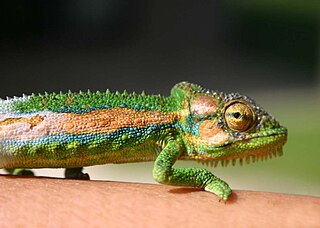
The Cape dwarf chameleon is a chameleon native to the South African province of the Western Cape, where it is restricted to the region around Cape Town.
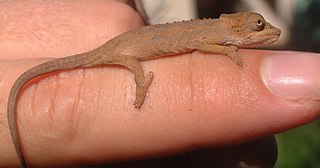
Setaro's dwarf chameleon is a species of lizard in the family Chamaeleonidae.

Smith's dwarf chameleon, also known as the Elandsberg dwarf chameleon, is a species of lizard in the family Chamaeleonidae endemic to Fynbos in South Africa's Eastern Cape. As in several species of chameleons in the genus Bradypodion, the Smith's dwarf chameleon can use its color-changing ability to actively camouflage itself depending on the vision of the specific predator species by which it is being threatened.

The Transvaal dwarf chameleon is a chameleon native to South Africa, where it is found in forested areas of Mpumalanga and Limpopo provinces. It is also known as the Wolkberg dwarf chameleon, after the Wolkberg range.

The Robertson dwarf chameleon, also known as the Little Karoo dwarf chameleon, is a chameleon in the genus Bradypodion. It is found in the dry Fynbos and Renosterveld shrub vegetation, in the centre of the Western Cape province, South Africa.
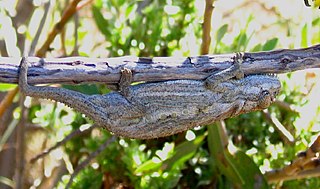
The Swartberg dwarf chameleon is a species of chameleon endemic to South Africa.
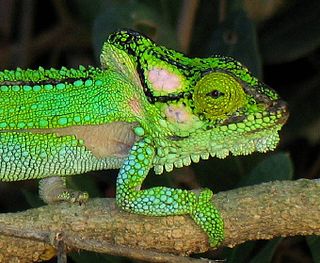
The Knysna dwarf chameleon is a species of dwarf chameleon in the Bradypodion genus that is endemic to South Africa. It is a forest dweller, found only in a limited range in the afromontane forests near Knysna, South Africa, and in certain surrounding areas.
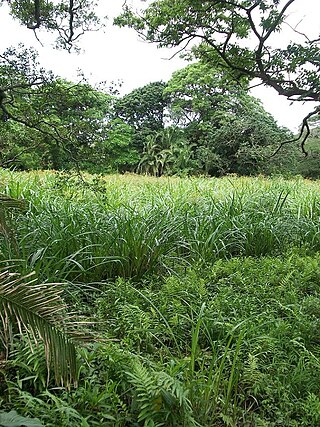
Ilanda Wilds is a nature reserve along Amanzimtoti River in the town of Amanzimtoti, KwaZulu-Natal, South Africa. This small area of land contains various habitat types, ranging from steep rocky slopes to various riverine habitats, forest and small patches of grassland.

Bradypodion ventrale, the southern dwarf chameleon, occurs in the Eastern Cape, South Africa. It is also known as the eastern Cape dwarf chameleon. It is a relatively large species of dwarf chameleon, reaching lengths of 14 cm (5.5 in). It has a very prominent casque on the back of its head and a long, beard-like throat crest. It lives in dense thickets and shrub, and is usually very difficult to spot because of its colouring. It adapts very well to living in suburban gardens, but domestic cats – being introduced predators – will usually kill all chameleons in the immediate area. Consequently, one should not bring chameleons into a garden which is frequented by cats. It gives birth to litters of between 10 and 20 babies in the summer.

The Drakensberg dwarf chameleon occurs in the Drakensberg, South Africa, between the latitudes of 27°45′ and 29°15′. Bright green dwarf chameleons found in the Drakensberg south of 29°15′ are now known to be more closely related to the Natal Midlands dwarf chameleon and may yet be described as a separate species.

The Namaqua dwarf chameleon or the western dwarf chameleon occurs in beach vegetation, along the west coast of South Africa and Namibia.
Ngome Forest is situated to the east of Vryheid, KwaZulu-Natal, South Africa. This is a unique forest, being transitional between Mistbelt Forest and Coastal Scarp Forest. The area has been protected since 1905, and forms part of the Ntendeka Wilderness Area.

The Karkloof Forest is situated in the Karkloof Nature Reserve, 22 km north of Howick, KwaZulu-Natal, South Africa.
The Weza Forest is also known as the Weza-Ngele Forest and is situated near Harding, KwaZulu-Natal, South Africa. This is a large Mistbelt Forest which has long been exploited for timber. The forest has been fragmented and reduced in size over many decades.
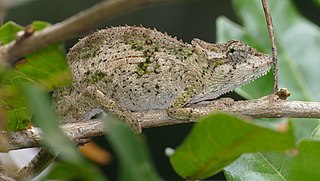
Bradypodion caeruleogula, the Dhlinza dwarf chameleon, Eshowe dwarf chameleon, or uMlalazi dwarf chameleon, is endemic to KwaZulu-Natal, South Africa. It is found in Dhlinza, Entumeni and Ongoye Forests.

The Maputaland-Pondoland-Albany Hotspot (MPA) is a biodiversity hotspot, a biogeographic region with significant levels of biodiversity, in Southern Africa. It is situated near the south-eastern coast of Africa, occupying an area between the Great Escarpment and the Indian Ocean. The area is named after Maputaland, Pondoland and Albany. It stretches from the Albany Centre of Plant Endemism in the Eastern Cape Province of South Africa, through the Pondoland Centre of Plant Endemism and KwaZulu-Natal Province, the eastern side of Eswatini and into southern Mozambique and Mpumalanga. The Maputaland Centre of Plant Endemism is contained in northern KwaZulu-Natal and southern Mozambique.

The southern rock agama or southern African rock agama is a species of lizard from the family Agamidae that occurs in Southern Africa in Zambia, South Africa, Eswatini, Mozambique, Zimbabwe and Botswana. It lives in small colonies on rocky outcrops, and the males are very conspicuous for their bright blue heads.
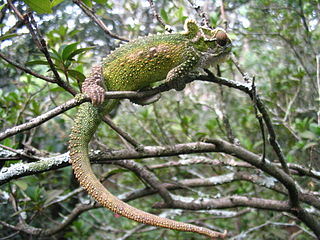
The Natal Midlands dwarf chameleon is a chameleon native to woodland habitat in the inland Midlands area of the South African province of KwaZulu-Natal.























